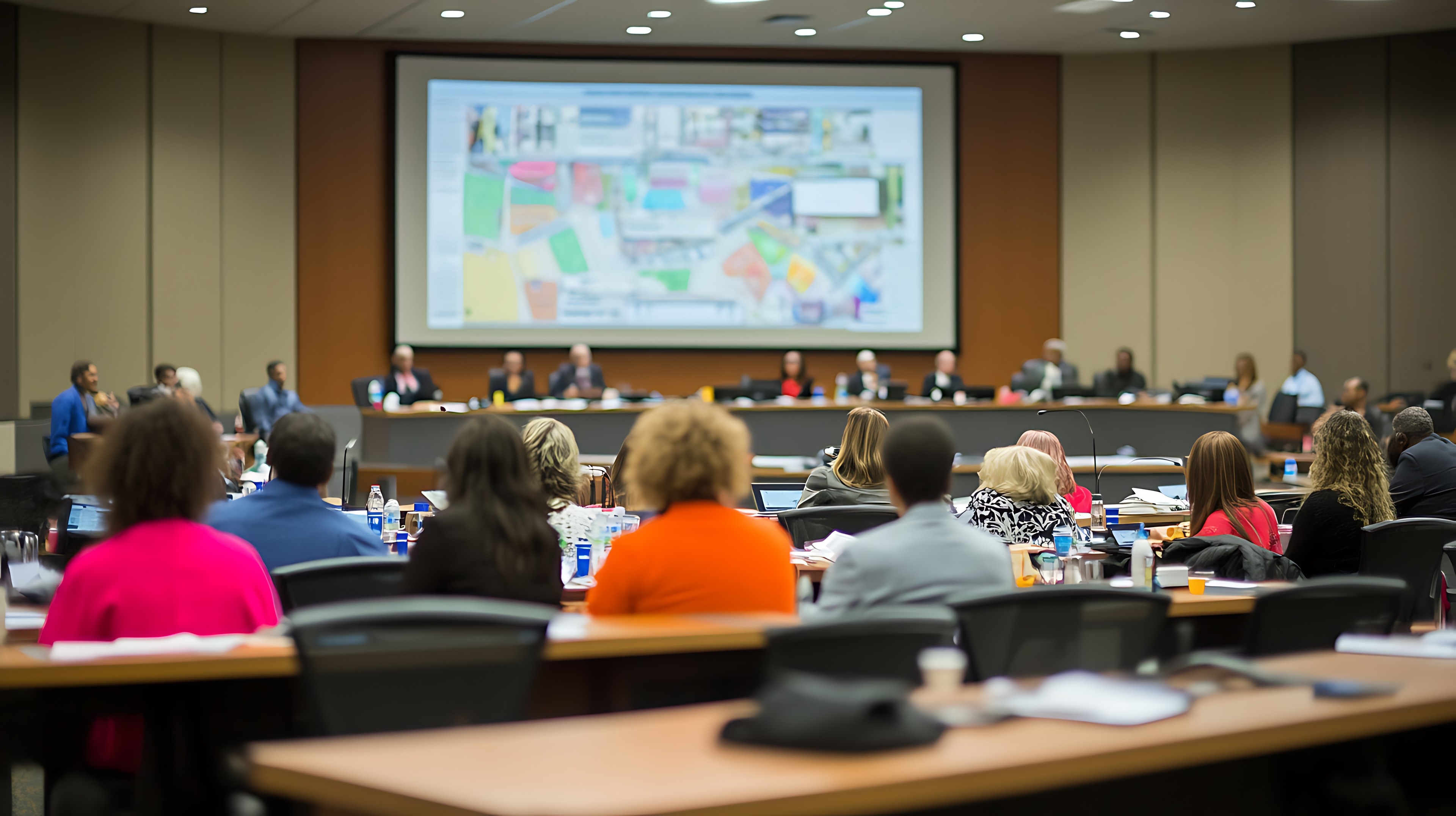Livestreaming regulations: What public facing boards need to know

For public boards of education and local government councils, livestreamed meetings are a powerful tool for engaging the community and building trust. They are also, increasingly, a legal requirement for public facing boards.
At the federal level, the Open Meetings Act requires disclosure of records and meetings, and the Americans with Disabilities Act (ADA) stipulates detailed requirements for in-person and virtual accessibility, from captions to sign language interpretation. At the state and local levels, however, policies vary widely, with a mosaic of jurisdictional norms and requirements that seem to change by the day.
An overview follows of livestreaming regulations in the U.S., diving deeper into:
- The many benefits of livestreamed public meetings.
- The states where it’s currently mandated.
- Factors to consider to remain compliant.
- Ways to stay ahead as the regulatory landscape evolves.
The many benefits of livestreamed public meetings
Legal compliance is just one of many reasons your board should embrace livestreamed public meetings. Importantly, livestreaming provides the transparency and accountability that build community trust.
Livestreaming allows the public to participate in meetings and events even if they cannot attend in person. It makes the meetings accessible to individuals with disabilities, those who live far from the meeting location, or those who have scheduling conflicts. After the fact, video archives provide a digital record that can be accessed for future reference.
This means that members of your community can see how decisions are being made on their behalf, with an openly available record of who said what.
Stay ahead in 2026
Get our latest public sector regulations outlook report and avoid costly surprises with expert-backed, actionable guidance.
I’d like the outlookEvolving regulations for livestreaming across the United States
Legal requirements for livestreaming public meetings vary widely from state to state, with more and more states requiring this or a similar practice or entertaining proposals for such a mandate.
What states currently have livestreaming legislation?
Live meeting feeds and archived recordings are increasingly becoming the rule of law across the United States, as the examples below illustrate:
- As of July 2025, all Indiana school boards, state agencies, counties, cities, towns and townships will be required to live stream its meetings and archive a copy of the meeting’s recording.
- Government boards in Montana are required to record public meetings by video or audio.
- A 2024 amendment to the Open Meetings Act in Vermont similarly requires electronically recorded meetings posted in a designated electronic location.
- In Arizona city government, a live audio feed is required if in-person meeting attendance spills out into “overflow” rooms beyond the original facility.
- Arkansas gives public boards options: a sound-only recording, a video recording with sound and picture, digital or analog broadcast capable of being recorded.
- Iowa requires access “by telephone or fiber optics.”
Which states are considering it?
As pressure increases for public engagement and transparency, more states may soon join the roster above — for example:
- A bill in Louisiana would mandate livestreamed public meetings for school boards, parishes and municipalities above certain population sizes.
- NHHB 1461 would require all meetings and hearings by elected or appointed municipal bodies in New Hampshire to be livestreamed or recorded.
- House Bill 412, introduced in January, would require livestreaming in Maryland.
- SB2571 was introduced in Mississippi with similar requirements.
- Colorado saw a proposal requiring state and local boards, councils and commissions to livestream many of their public meetings and offer remote public testimony.
- The New York state legislature is considering a bill that mandates hybrid public meetings at the state and local level.
- In Wyoming, HB0203 would require audio or video access to public meetings “to the extent practicable.”
What to do if your state isn’t mentioned in the lists above
Watch the landscape closely. A state like Alaska may currently have no official requirements for meeting minutes or recordings, but this situation could change any day. Or maybe a proposal related to virtual meetings recently stalled, as was the case in California. This momentum could quickly resume with new technologies, shifting norms and public sentiment.
In the meantime, look at what other municipal and public education boards are doing to engage their stakeholders and be transparent in their work. Draw from their examples to shape your own activities
Finally, keep a close eye on the fine details related to virtual participation and recordings. Some of these can be very specific, as the following examples demonstrate.
What legal stipulations should you be aware of? Your FAQ answered
Who’s allowed to record?
With more and more members of the public carrying a portable video device in the form of their smartphone, you’ll need to be aware of these rules. In Alabama and Pennsylvania, meeting attendees are allowed to record a public meeting as long as their actions are not disruptive.
What caveats and conditions apply to virtual and recorded meetings?
Idaho authorizes audio conference calls if at least one member of the governing body is present at the physical meeting location and if the meeting is audible to all members in attendance.
Tennessee similarly allows “internet forums,” as long as they don’t “act as a substitute for decision making by a governing body at a meeting held in accordance with the Tennessee Open Meetings Act.”
How must meetings be memorialized for future reference?
In Washington State, all school districts must save audio recordings of school board meetings for at least one year. In Oregon, school and education service and community colleges must video record meetings and post the recordings online within seven days, with an audio recording allowed if broadband internet access is unavailable.
What stipulations exist for quality control?
- Florida rules for virtual meeting prioritize accessibility. “Enable closed caption if available especially if conducting a live stream video via Facebook or YouTube.”
- West Virginia allows speaker phone or a computer with audio or video feed in a city council meeting room and invite the public there, but with the caveat that “steps should be taken to ensure that members of the public and press are able to hear meeting participants.”
- Texas’ rules for city council meetings require that “each participant’s face in the videoconference call, while speaking, must be clearly visible and audible to each other participant and, during the open portion of the meeting, to the members of the public in attendance.”
Ditch risky platforms
Avoid compliance pitfalls and public frustration with livestreaming that is open, interactive and easy to follow, no matter where your audience is.
Learn moreGetting started with livestreaming: Legal checks and other musts
As a board secretary or clerk, it’s your job to know the rules of the road, from data privacy concerns and copyright issues to public notifications and beyond. And even if your official job title isn’t AV manager, you’re responsible for technical details like the quality of the stream, the reliability of the platform, and the security of the data transmitted.
How do you make sure your livestreamed meetings meet the compliance requirements of regulators and the needs of your community?
Legal mandates are a good place to start
After checking overall livestreaming requirements at the federal, state and local levels, delve deeper into details like:
- Terms and conditions that must be communicated to participants, like notifying them that the meeting will be recorded.
- Regulations over the collection and storage of data.
- Extra accessibility features you’ll need to include, like closed captioning and sign language interpretation.
Examine your official meeting policies
Your house rules may need to adapt to livestreaming technologies and virtual participation. This means you’ll need to take a look at things like:
- Rules of engagement, such as time limits, dress codes, protocols for addressing the board, and behavior that won’t be tolerated.
- How you’ll handle public engagement (written and verbal) before, during and after the meeting, including how comments will be incorporated into the official meeting record.
- How you’ll handle interruptions and breaks.
- Meeting scheduling and public notifications.
Pay attention to the technical details
As the regulatory landscape continues to take shape, execution matters, as implementation challenges related to Hawaii’s 2022 open meetings law demonstrate. “Several government board meetings including panels on wastewater and game were canceled in January due to the lack of functioning Zoom links and a failure to provide contact information on the public meeting agendas.”
Don’t let connectivity and IT glitches annoy your community, weaken your credibility and threaten public trust. Before you start livestreaming, go through a technical walk-through with your IT and AV teammates to review:
- Bandwidth for the broadcast
- Internet connections
- Camera angles and lighting
- Microphone placement and sound quality
- Batteries and backup
After each meeting, consider gathering feedback from community members and meeting participants about their experiences. Also look at audience engagement metrics such as viewership numbers to guide future efforts.
Stay ahead of regulatory change
Check out our comprehensive — and continually updated — regulatory roundups for board training, AI and more.
Explore more useful resources
Download this helpful checklist for more detail on vendor evaluation, technical set-up and logistical preparations.
Go deeper into legal mandates, best practices and platforms, including real-life case studies, with this comprehensive guide to compliant livestreaming.
Dive into why public boards should resist the temptation of social media platforms for their livestreaming needs.
Read about livestreaming’s potential to attract new residents and families to your community, building confidence in the school system and city council.
Discover how Glenbrook High School District 225 in Illinois moved from cumbersome off-the-shelf solutions to Diligent Community Livestream Manager, to improve livestreaming quality and increase community engagement. A split screen view provides the public with the ability to listen, watch and actively review resources that the board references during deliberations. Attendees can also access captions, while recordings are saved for easy search afterwards.
The final step: the right livestreaming solution
You’ve read about the trends. You have the tools and tactics. Now it’s time to bring technology into the equation.
It may be tempting to turn to a general-use videoconferencing service or social media streaming platform. For security and compliance reasons alone, resist this temptation. A specialized livestreaming platform, integrated into a comprehensive governance platform, will deliver the quality, scalability and confidence you need, along with seamless administration.
- Before the meeting, you should be able to set up and schedule the livestream directly from within the solution, with minimal steps.
- During the meeting, the livestreamed meeting should integrate with your public website, ideally directly beside the published agenda so your community can follow along, supported by features like live closed-captioning, multiple camera feeds, image overlay and a profanity filter.
- After the meeting, look for the ability to review and edit captions, add timestamped minutes alongside the recording, make content easily discoverable and create meeting minutes with AI.
Diligent Community delivers all of these benefits and more, bringing super-reliable live HD video — backed by best-in-class provider BoxCast — and Livestream Manager together into a meeting experience that pleases regulators, board members and your community, now and as the landscape evolves.
Schedule a demo today.
More to explore

How streaming for public meetings enhances accessibility and engagement
Explore the significance of streaming for public meetings helping to enhance accessibility, inclusion and engagement

Livestreaming your public meetings: Benefits of purpose-built providers vs. free social platforms
Using streaming on social platforms may seem like an easy option but there are things to consider when choosing a service for your public meetings

Proven ways to streamline your livestreaming process
Learn tips for preparing to livestream, managing the streaming process and post-meeting procedures.

Livestreaming and transparency: Bringing people to your district or municipality
Discover how livestreaming can enhance transparency and community trust in local governance, making meetings accessible to all and attracting new residents.

